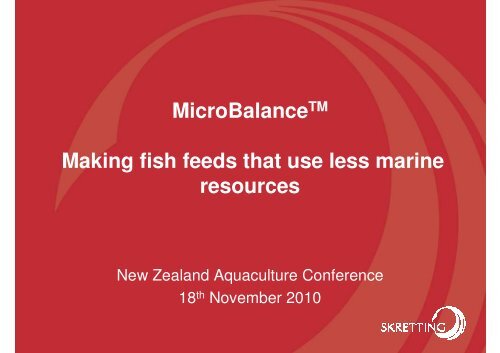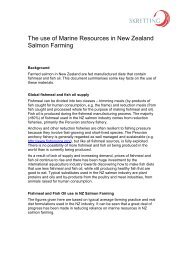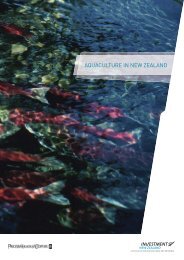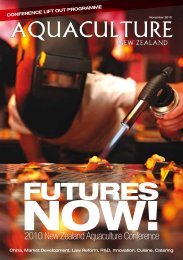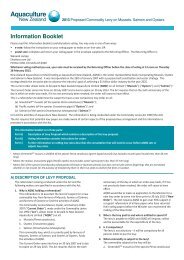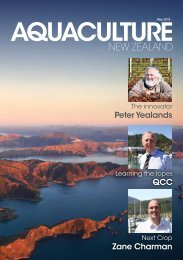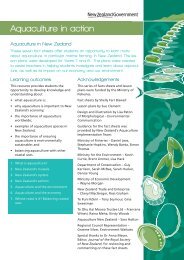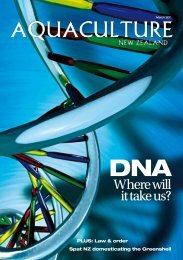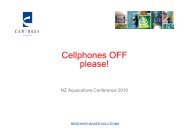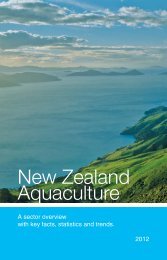Dr Rhys Hauler - Aquaculture New Zealand
Dr Rhys Hauler - Aquaculture New Zealand
Dr Rhys Hauler - Aquaculture New Zealand
- No tags were found...
You also want an ePaper? Increase the reach of your titles
YUMPU automatically turns print PDFs into web optimized ePapers that Google loves.
MicroBalance TMMaking fish feeds that use less marineresources<strong>New</strong> <strong>Zealand</strong> <strong>Aquaculture</strong> Conference18 th November 2010
The Mission that guides us:Skretting delivers outstanding nutrition andservices to fish farmers worldwide for thesustainable production of healthy anddelicious fish.
Sustainable Economic Aquafeeds• As an industry leader, Skretting wishes tocontribute globally - in cooperation with itspartners in the production chains for farmed fish- to a sustainable use of natural resources andthe conservation of the environment and itsbiodiversity.• The SEA programme describes how we developand produce our products in order to achieveour ambitions to deliver sustainable feeds.
Our dilemma• <strong>Aquaculture</strong> is seen as the only source for meeting the growingdemand for fish as food, because the catch from wild fisheriescannot increase. At the same time, fisheries provide fishmeal andfish oil which are important raw materials for fish feed. Demandfor feed must be balanced with the sustainable supply.
GarlicBeans, dryRyePalm oilSunflower seedRapeseedCoconutsOur dilemma - Fishmeal5.0World Crops 2009 (FAO)4.54.03.53.02.52.01.51.00.50.0Fish meal (IFFO)Fishoil (IFFO)MaizeWheatRicePotatoesSoybeansOil palm fruitBarleyTomatoesBananasApplesOrangesGrapesCottonSorghumMillion tonnes
Our dilemma - Fishmeal900Availability of Garlic is 3 times higher than Fishmeal…!World Crops 2009 (FAO)8007006005004003002001000Fish meal (IFFO)Fishoil (IFFO)MaizeWheatRicePotatoesSoybeansOil palm fruitBarleyTomatoesBananasApplesOrangesGrapesCottonSorghumRapeseedCoconutsPalm oilSunflower seedBeans, dryRyeGarlicMillion tonnes
Source and graphics: Holtermann Sept 201033% reduction!
Source and graphics: Holtermann Sept 2009
Source and graphics: Holtermann Sept 2009
How to solve our dilemma:• Develop the nutritional knowledge needed tobecome less dependent upon fishmeal and fish oil• Source fishmeal and fish oil from responsiblymanaged fisheries
Sustainable Economic AquafeedsThe main guiding principles are1) Use resources efficiently2) Use sustainable resources3) Operate feed production in a socially andenvironmentally responsible manner
PrincipleUse resources efficiently
Our goal is to have the nutritionalknowledge to become a net fish proteinproducer<strong>Aquaculture</strong> not only consumes fish – it also produces fishWe should useless protein fromfish in the feed……than fish proteinproduced throughaquaculture
MicroBalance TM• The correct balance of micro nutrients allowing areduction in the dependency on single raw materials,and ensuring that substitution can be done withoutreduction of fish performance (growth, feed conversion,health and flesh quality)
Reduction using known micro nutrients (small fish):Atlantic salmon (70 – 600 g)Growth from 30% down to 15% fishmeal (summer)1.901.801.701.60SGR (%/day)1.501.401.301.201.101.00FM 30 FM 25 FM 20 FM 15ns
Reduction using known micro nutrients (large fish):Atlantic salmon (2-4 kg)Growth from 30% down to 15% fishmeal (winter)0.7a a0.6abb0.5SGR (%)0.40.30.20.10FM 30 FM 25 FM 20 FM 15
Reduction using known micro nutrients (large fish):Atlantic salmon (1.7-3.0 kg)Growth from 30% down to 15% fishmeal (summer)1.000.900.80aabIs this aboutfeed intake?abSGR (%)0.700.60b0.500.400.30FM 30 FM 25 FM 20 FM 15
Examine gut and health parameters:The size of different segments of the gutrelative to total body weight353025g/kg body weight20151030 % FM25% FM20% FM15% FM50Stomach Pylorus Pyloric MidMid+distaland hind gut
Levels of gut inflamationScore 1 Score 3 Score 5
What affects metabolism?Screening trial 1 (1 – 2.5 kg = Large fish)0.90.80.7aabababbabababbab ab ab0.6SGR (%/day)0.50.40.30.20.10A B C D E F G H I J O P30% 15% 15% + active micro nutrients
What effects the metabolism?“Metabolic profiling” shows that circulatingmetabolites change in the right direction238 metabolites analysed in total15%15%+30%
Different doses of micro nutrients tested:Comparing the size of the pylorus35Before30g/kg body weight2520151050Conclusion:Stomach Pyloric Mid+distal30 % FM25% FM20% FM3515% FMWe have unravelled the fishmeal mystery!Pylorus weight (g/kg body weight)Pylorus weight (g/kg body weight)302520151050Now30 % 15 % 15%+
Check health and flesh quality parameters:Health parameters• No effect seen on:– ALP– Gallic acid– Coenzyme Q10– Cholesterol– AST– ALT– Triglycerides– Protein– Albumin– Urea– Circulating minerals (P, Ca, K, Cl)
Check health and flesh quality parameters:Flesh quality parameters• Pigment – No difference– Visual / chemical (NQC) analysed• Fillet fat – No difference• Texture – No difference
Nutritional knowledge versus economicuse• Today the levels of fishmeal and fish oil inaquaculture diets are determined by the economicvalue of these raw materials• Skretting cannot impact the economic value, butwe have developed the nutritional knowledge touse less of these raw materials, and becomeindependent of their use• Today we have the nutritional knowledge to usefar less than the level determined by currenteconomic value
Fishmeal in Commercial NZ Salmon DietsCurrent Minimum
Wild Fish used for fishmeal in NZ salmondietsCurrent Minimum
Fish Protein Out vs Fish Protein InNZ salmon farmingCurrent Maximum
MicroBalance TM : the nutritionalknowledge to become a net fish proteinproducerWe should useless protein fromfish in the feed……than fish proteinproduced throughaquaculture


